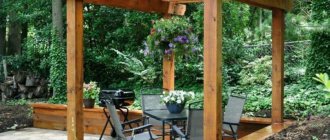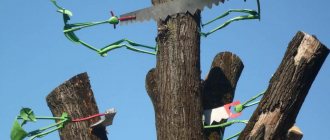The ground cover plant lobularia has won the hearts of many gardeners. It is unpretentious, blooms until frost, reproduces with gemstones and has a pleasant aroma. The modest but exquisite beauty of the flowers goes well with the bright representatives of the flora, and mixborders and borders decorated with lobularia look amazing. How to properly plant and care for these magnificent flowers?
Garden design
Garden designers prefer to use purple, white and mixed shades of this border crop for edging lawns, paths and mixborders. They have neutral colors, so other annual and perennial flowers look amazing against their background. Relief flower beds: rockeries and rock gardens will become well-groomed and complete if they are supplemented with miniature bushes, densely showered with flowers. The duo of lobularia with flowers of warm, rich shades looks impressive: marigolds, zinnia and nasturtium.
Lobularia is used for landscaping balconies, terraces, and patios - its honey aroma and spectacular appearance will appeal to any connoisseur of beauty.
"Fragrant mix"
Wide ribbon flower beds, borders, and arrays can be decorated with another variety of lobularia - “Fragrant Mix”. The bushes of the species are low-growing, reach a height of 8-12 cm, are compact and have moderate branching. From the photo of the lobularia in the flowerbed it can be seen that this variety has a different color.
White, pink and purple star flowers with a diameter of 4 mm are collected in clusters of inflorescences and have a pleasant honey aroma. They completely cover the bushes during flowering, which lasts from June to October. To grow the variety, gardeners resort to the seedling method and direct sowing into the soil.
Popular varieties
The following plant varieties are recognized as the best:
- Palette. The height of the plant reaches 10 cm, it is distinguished by the varied colors of the inflorescences: crimson, pink, brown-red, lilac, white.
- Tiny Tim. Dwarf plant with white flowers.
- Wise Risen. Large snow-white inflorescences.
- Easter Deep Rose. It is characterized by abundant flowering, the color of the petals is intense pink.
- Violet Konigin. Large purple flowers.
- Rosie O'Day. The height of the bush is up to 10 cm, the color of the petals is pale pink.
- Easter Bonnet Pink. Compact bushes covered with light lilac flowers.
- Princess in Pearl. The shoots are long, reaching 35 cm, the flowers are pale lilac, the variety looks great in baskets and hanging flowerpots.
At first glance, the inflorescences may seem too modest, but the incredible aroma that envelops this plant will make everyone fall in love with it.
"Easter Hat"
"Easter Hat" is an early flowering annual variety of lobularia. The plant belongs to one of the earliest representatives of the Cabbage genus. A distinctive feature of the species is its short stature, which creates a carpet-like effect. The average plant height is 10-20 cm.
The Easter Hat variety is characterized by intense and abundant flowering. It retains its decorative properties for a long time, so it is often used for arranging plantings and flower beds. Experienced gardeners note the versatility of this species, its relative unpretentiousness to its habitat and its ability to tolerate light frosts and droughts.
Important! It is recommended to grow alyssum by planting seeds for seedlings. The optimal time for this is April. After waiting for germination, in the second half of May you can plant it in a flowerbed.
How to grow seedlings at home?
A beautiful thick carpet of lobularia is obtained when ready-made seedlings are planted in the ground, and more than a dozen plants must be used. The annual plant also reproduces by seeds; they are sown in the soil in spring or autumn. Why do experienced gardeners prefer to plant seedlings, what are the advantages of this method? So this is:
- the possibility of uniform planting, eliminating the occurrence of bald spots if the seeds do not germinate;
- early and long flowering, the first flowers appear in May;
- the influence of spring frosts is excluded.
Growing seedlings from seeds is the most effective way to obtain beautiful and healthy plants. What needs to be done for this?
Diseases and pests
In principle, this species is very hardy, is not attacked by pests and is not susceptible to various diseases. Problems can only arise if the planting is improper, too dense, in which case the plant may develop mildew and other fungal diseases. Remove diseased bushes to avoid infecting neighboring plants. Treat shrubs with a fungicide during the flowering period.
Sowing seeds
For sowing, seeds are used that are stored for no more than 3 years in suitable conditions; they are the ones that have the greatest germination rate. The first shoots appear within 10-15 days if the container with soil is stored in suitable conditions. Plastic containers can be used as containers for growing seedlings; they are mini-greenhouses in which a greenhouse effect is created. Light soil with good air exchange is suitable; river sand or peat can give it these properties. Growing lobularia from seeds requires some knowledge. For example, before sowing, the soil should be moistened and a manganese solution should be added for disinfection.
Only after this, shallow grooves are drawn, seeds are sown on the surface of the soil, and a small layer (no more than 0.5 mm) of sand is sprinkled on top. The container is covered with a transparent lid on top and sent to a bright, warm place. Caring for seedlings involves daily ventilation and spraying the soil with a spray bottle if it is dry. Over-watering should be avoided.
The best time for sowing is the first half of March, since it is at this time that daylight hours increase and there is a high probability that the seedlings will grow healthy and strong.
You can sow seeds on the surface of the snow; as it melts, it will draw the seeds into the soil to the required depth, and as a result of short-term cooling, stratification will occur, which guarantees the rapid growth of the seed.
"Rosie O'Day"
Marine lobularia "Rosie O'Day" attracts experienced gardeners with its originality and honey production. The flowers of this variety are voluminous and purple-white in color. Additional characteristics are:
- low bushes, 10-15 cm in height;
- multi-component inflorescences, which consist of several dozen flowers, 3 mm in diameter;
- voluminous bushes form a neat carpet;
- flowering from early summer to October.
Alyssum is grown according to the rules of agricultural technology. Seeds for seedlings are sown in March (in the greenhouse method); planting in the ground is carried out in mid-May. The soil chosen is fertile and not heavily shaded. A distance of 20 cm is maintained between seedlings.
Did you know? The name alissum comes from “alisso” and is translated as wandering, wandering.
Sources
- https://lovgarden.ru/sadoviye-cveti/odnoletniki/tsvetok-lobulyariya-i-ego-vyrashhivanie-iz.html
- https://chto-posadit.ru/tsvety-lobulyariya-vyrashhivanie-iz-semyan-v-domashnih-usloviyah-posadka-i-uhod-v-otkrytom-grunte/
- https://agronomu.com/bok/4238-cvetok-alissum-lobulyariya-luchshie-sorta.html
- https://zakupator.com/sad/lobulyariya.html
- https://7dach.ru/LenaMedvednikova/kak-vyrastit-lobulyariyu-i-ne-pereputat-ee-s-alissumom-127534.html
[collapse]
Seedling care
After the first shoots, seedlings need constant care. If there are too many seedlings, you can thin them out, leaving 2-3 pieces each. The distance between seedlings is about 10 cm. Another way is to dive - transplant each seedling into a separate glass or pot, you can take several pieces in case one does not take root. Well, to make growing perennial plants enjoyable, it is better to plant them in open ground after May 10, when the risk of morning spring frosts is minimal.
"Purple Queen"
A miniature plant from the Cruciferous family. Produces low, compact, branched bushes no more than 15 cm high each. Photos and descriptions of this alissum flower allow us to determine the main characteristics of the variety:
- one year old;
- flexible shoots;
- small purple flowers, up to 4 mm in diameter;
- flowering from early summer to October;
- good survival rate.
Material for sowing is purchased and planted in the soil in April. Adherents of the seedling method are advised to organize sowing in March and plant in May.
Important! It is necessary to maintain a distance between plants. To do this, the seedlings are thinned out, maintaining a distance of 8-10 cm.
Landing in the ground
Lobularia is planted in groups to create a uniform flower cover; caring for a perennial plant will only bring pleasure if you choose a sunny area, not shaded by tree crowns, with dry, fertilized soil. Flowers respond well to the heat emanating from heated bricks and stones, so they grow well near a paved path or border.
Before planting, dig up the soil, add peat or compost, then follow the following procedure:
- We dig holes, keeping an interval of 40-50 cm. The flower grows well, so it is not worth planting too closely.
- We take each plant out of the cup, trying not to damage the earthen ball, and plant one in each hole.
- Cover with soil and water generously.
- Mulch with peat or humus. Mulch prevents weed growth and protects the soil from excessive drying out.
6-7 weeks after planting, with careful care, the first flowers will appear on the plant.
"Golden Queen"
Alyssum “Golden Queen” is an annual plant reaching a height of 10-20 cm. The variety is characterized by active flowering from June to October and bright yellow colors of small flowers.
Designed for ground cover plantings and is able to fill all the voids with colorful inflorescences with the aroma of honey. Alyssum inflorescences are dense, form cushions, and in general - a floral carpet that covers the soil from the summer heat.
This variety is also drought-resistant and moderately frost-resistant. It is grown mainly by seedlings from late February - early March, maintaining an air temperature of about 12 °C. With the appearance of the first three leaves, the seedlings can be picked. After 6-8 weeks the plant blooms.
Alyssum is used for decoration next to supporting walls, to create voluminous borders and rock gardens.
As ground cover, you can also plant creeping tenacious, nemophila, dichondra, saxifrage, armeria, and periwinkle.
Lobularia care
The plant is not quite picky, so growing and caring for it does not cause much trouble. Caring for a perennial beauty comes down to the most common measures.
Watering
Water the plant as needed; it needs abundant watering only during periods of drought. The crop does not tolerate excess moisture in the soil, so the area needs to be moistened if the top layer has dried out by 3-4 cm. This can be easily checked by lifting a lump of earth with a shovel.
Loosening and fertilizing
For the best penetration of air and moisture into the soil, you need to take care of systematic loosening. Caring for a plant is unthinkable without applying fertilizers. During the growth period, nitrogen fertilizer is applied, and before flowering, complex fertilizer is applied. The optimal amount of fertilizing is 2-3 times per season.
A haircut
Shoots should be cut to 5-6 cm after the first wave of flowering. It will provide not only a well-groomed appearance, but also the further formation of new buds. This is one of the care rules that cannot be applied to all crops, but lobularia, after shortening the shoots, will delight you with lush flowering until frost.
Wintering
Even with proper care, lobularia will not survive the harsh winter in regions where the air temperature drops below -15° C, therefore, in order to preserve the crop, it is advisable to collect seed material in the fall. After tearing off the dry inflorescences, they should be ground over a cloth or paper and the seeds should be separated from the large dust. They are aged for several days in a dry, ventilated area, then packaged in paper bags and stored until spring.
If the temperature in the region in winter does not fall below the limit, then in the fall the bushes are covered with a layer of dry leaves, and in the winter a snowdrift is thrown over the leaves. Before wintering, the bush is not pruned, as this can lead to the death of the plant. Dried leaves and last year's inflorescences and fragile shoots are disposed of in the spring.
Description of the plant
Lobularia is a perennial and annual herbaceous plant belonging to the cruciferous family. This flower is native to the Mediterranean region. Most preferable on moderately fertile, drained, neutral-acid soils.
Lobularia flowers are undemanding to lighting; they grow quietly both in direct sunlight and in diffused light, but in open spaces the flowering is more intense and bright.
Lobularia reproduces by seeds. Cultivated annual plants, up to 40 cm high and up to 15 cm wide, low-growing, compact, densely branched.
The leaves are narrow, lanceolate, tufted, elongated, dark green, arranged alternately on the stem, most of them concentrated in the lower part of the plant. During flowering, the stem becomes stiffer and more branched.
Tiny white-blue flowers are collected in cross-shaped, umbrella-shaped, spherical inflorescences. One flower has four rounded petals. The smell is strong, honey-like and very aromatic, attracting many butterflies and bees.
After flowering, a fruit is formed - an oval pod with a sharp tip. Because of its shape, the plant is called lobularia, from the Latin lobulus, meaning small pod. The pod contains about 3,000 small seeds that remain viable for 3 years, varying shades of yellow or brown.
Many gardeners equate lobularia and alyssum, but others believe that combining these names is unnecessary. They belong to the same family and are very similar in appearance. Alyssum is a low perennial, and lobularia marine is an annual plant.
When does lobularia bloom?
The plant can delight with its beautiful flowers from early summer until late autumn, until the first frost. In severe drought and heat, flowering is interrupted. As soon as the right temperature is established, the bush will bloom again.











